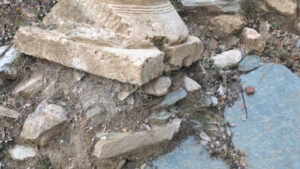Architectural remains of a sanctuary building were brought to light by excavation by the Ephorate of Antiquities of Larissa at the “Skiathas” site, in an area where a marble threshold and parts of walls could be seen.
According to an announcement by the Ministry of Culture and Sports, the excavation data so far show that it is a sanctuary of Hellenistic times (3rd-2nd century BC), made of alabaster and local stone. Architectural members were found, such as part of the entablature and five Doric-style capitals. A statue pedestal, a column section, a marble bank leg, as well as two marble heads of children, a girl, and a boy were also found inside.
According to the same announcement, in the coastal area of Kato Polydendri of the Municipality of Agia of the Larissa Prefecture and specifically in the place “Skiathas”, next to the port of Agiokampos, salvage operations are underway in the forested and inaccessible acropolis of the designated archaeological site, as structures have been uncovered after extreme weather or human intervention. The research is being carried out under the supervision of archaeologist Nektaria Alexiou.
The ancient settlement at this location extends on a low hill to the eastern foothills of Mount Mavrovouni that connects the Ossa mountain range to the north with the Pelion mountain range to the south. It is a walled settlement, covering an area of 55 acres, which also had a natural fortification, a deep stream to the north, west, and south.
Built on stepped terraces, it stretched east to the sea and reached the rocky shores of the northern Aegean. It had two natural coves that were probably its ports. In the past, research had been carried out by the honourary curator of Antiquities A. Tziafalia to uncover the citadel wall. Important finds have come from the area, such as sculptures, ceramics, coins, most of them from the classical and Hellenistic eras, which are kept in the museums of Larissa and Volos, while some are on display.









Ask me anything
Explore related questions





